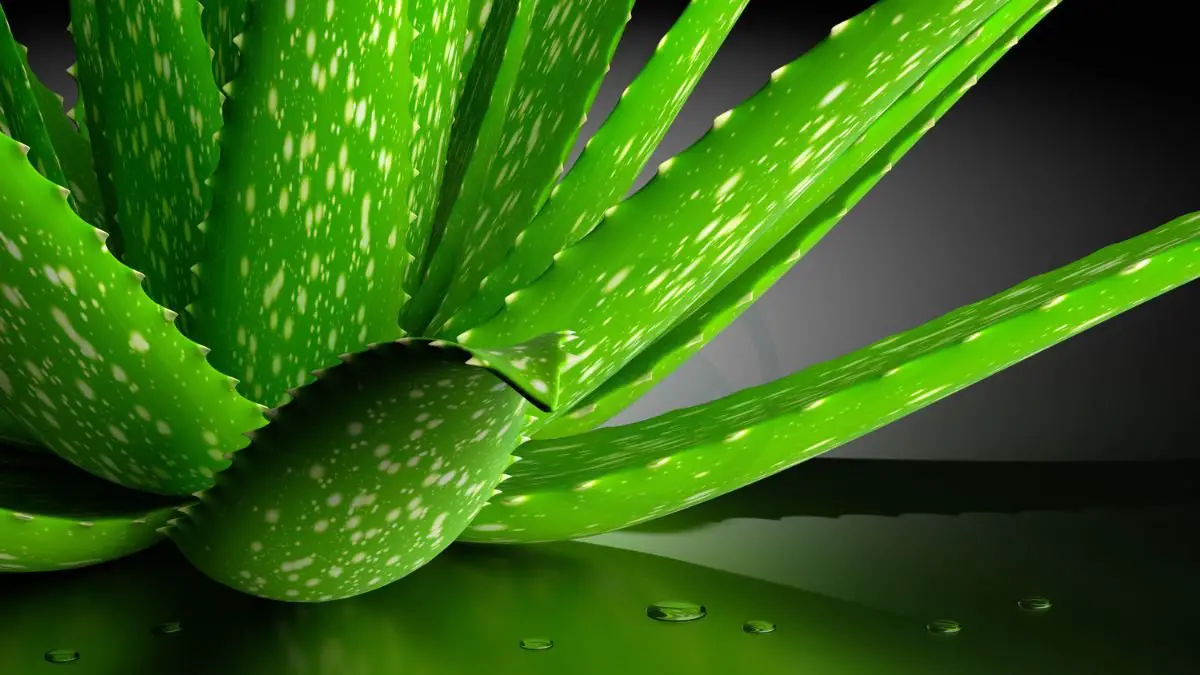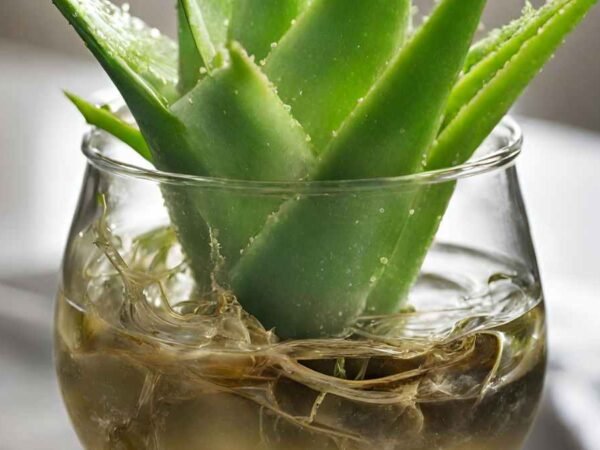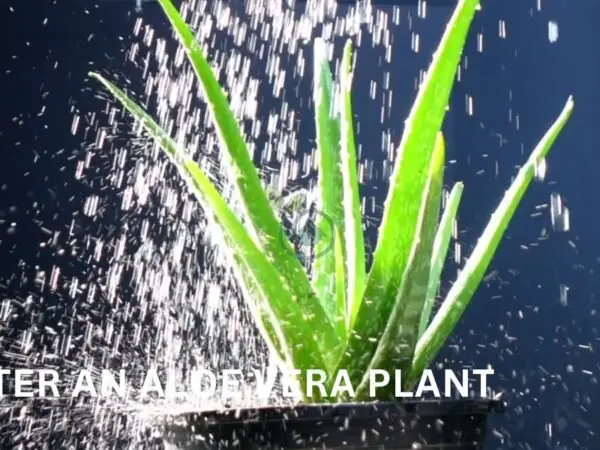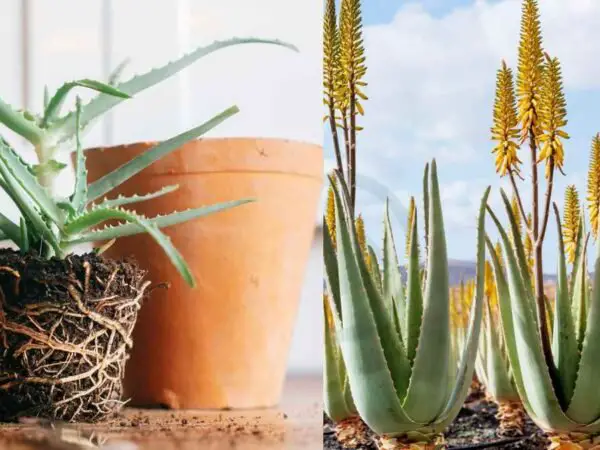Wondering, "How often do I water aloe vera?" You're in the right place! Understanding the watering needs of your aloe vera plant is crucial for its health and growth. Let's explore this together.
Aloe vera plants are succulents known for their ability to store water in their leaves. They prefer infrequent watering, typically every 2-3 weeks during the growing season (spring and summer) outdoors. In winter, reduce watering to once a month or less, as the plant enters a dormant period. Always allow the soil to dry out completely between waterings to prevent root rot. Remember, it's better to underwater than overwater your aloe vera.
Still curious about aloe vera care? Discover more about its sunlight requirements and potting soil preferences to ensure your plant thrives!
Key Takeaways
- Water aloe vera sparingly, allowing the top 1-2 inches of soil to dry out between waterings to prevent root rot.
- Ensure optimal soil drainage by using a well-draining cactus mix and a pot with drainage holes to prevent waterlogged roots.
- Fertilize aloe vera lightly during the growing season with a balanced fertilizer diluted to half strength to support healthy growth.
- Regularly prune dead or damaged leaves and remove offsets for propagation to maintain a tidy and thriving aloe vera plant.
- Address common issues like overwatering, sunburn, or pests promptly to prevent them from affecting the health of your aloe vera.
- Create ideal conditions for aloe vera by providing bright indirect sunlight, warm temperatures, and good air circulation to promote vigorous growth.
Essential Aloe Vera Facts
Fast Facts
Aloe vera plants require minimal care and are drought-resistant, making them ideal for beginners. Water aloe vera sparingly, allowing the soil to dry out between waterings. Overwatering can lead to root rot, so it's crucial to avoid soggy soil.
- Aloe vera thrives in bright, indirect sunlight but can tolerate some shade.
- The plant prefers temperatures between 60-75°F (15-24°C) and is sensitive to cold drafts.
- Use a well-draining potting mix and ensure proper drainage to prevent waterlogged roots.
Ideal Placement
Position your aloe vera plant near a south or west-facing window to provide adequate sunlight. Avoid placing it in direct sunlight for extended periods as it can scorch the leaves. Ensure there is ample airflow around the plant to prevent humidity buildup.
- Consider placing your aloe vera plant in a room with temperatures that mimic its native environment.
- Avoid exposing the plant to sudden temperature changes, such as drafts from air conditioning or heating vents.
Light Requirements
Aloe vera plants require 6-8 hours of indirect sunlight daily for optimal growth. If natural light is insufficient, consider using grow lights to supplement their light needs. Monitor your plant for signs of sunburn, such as reddish-brown spots on the leaves.
- Rotate your aloe vera plant periodically to ensure even light exposure on all sides.
- If growing indoors, place the plant near a window with sheer curtains to filter intense sunlight.
Temperature Needs
Maintain temperatures between 70-85°F (21-29°C) during the day and slightly cooler at night for healthy aloe vera growth. Protect the plant from temperatures below 50°F (10°C) as it can damage the leaves and halt growth. Consider using a thermometer near the plant to monitor temperature fluctuations.
- During winter, protect your aloe vera from cold drafts by moving it away from windows at night.
- If outdoor temperatures drop below 50°F (10°C), bring your aloe vera indoors to prevent cold stress.
Optimal Soil and Potting
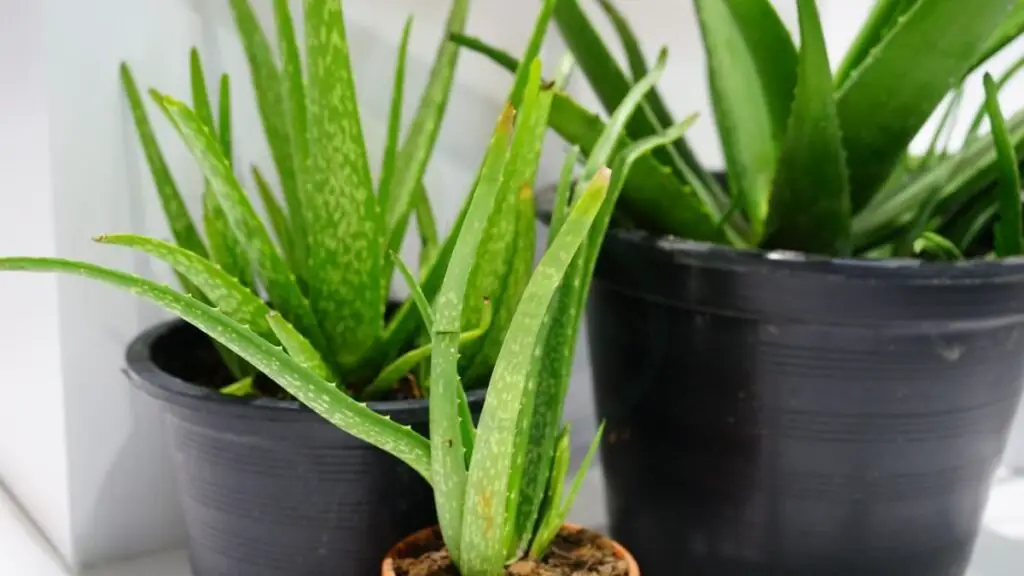
Best Soil Mix
When potting aloe vera, ensure you select a well-draining soil mix to prevent root rot. This type of soil allows excess water to flow out easily, keeping the roots healthy. Understanding the ideal soil composition for aloe vera is crucial for its growth.
Potting Tips
Follow these essential tips when potting your aloe vera plant: choose a pot with proper drainage holes, use a well-draining soil mix, and avoid overwatering. Knowing the right pot size and considering drainage are key factors for the plant's health.
Repotting Aloe Plants
Recognize the signs indicating it's time to repot your aloe vera, such as roots growing out of the drainage holes or overcrowding. When repotting, carefully remove the plant from its current pot, inspect the roots for any issues, and replant in fresh soil. Repotting can significantly benefit your plant's overall health and growth.
Watering Aloe Vera Correctly
Identifying Watering Needs
Signs of Thirst
- Notice when the aloe vera leaves start to wrinkle or become soft.
- Observe if the soil is completely dry and pulling away from the pot's edges.
- Differentiate between signs of thirst and symptoms of other issues like pests or diseases.
Overwatering Symptoms
- Spot yellowing leaves that feel mushy to the touch.
- Understand that overwatering can lead to root rot and stunted growth.
- Avoid watering too frequently to prevent overwatering-related problems.
Watering Frequency
- Establish a watering routine based on the plant's specific needs.
- Ensure consistent moisture without letting the soil become waterlogged.
- Adjust watering frequency according to factors like temperature and humidity levels.
Preventing Over and Underwatering
When it comes to preventing overwatering, always ensure proper drainage in the pot. Avoid using pots without drainage holes as they can lead to water accumulation at the roots. Consider using a well-draining soil mix to prevent waterlogging. On the other hand, under-watering can be avoided by monitoring the soil moisture regularly. Remember that aloe vera plants prefer slightly drier conditions compared to being overwatered.
Fertilizing for Healthy Growth
Fertilizer Types
Aloe vera plants benefit from balanced fertilizers that contain equal parts of nitrogen, phosphorus, and potassium. These nutrients support healthy growth, vibrant leaves, and robust root systems. Organic fertilizers like compost or diluted fish emulsion are excellent choices for aloe vera.
When selecting a fertilizer for your aloe vera, opt for a water-soluble formula to ensure easy absorption by the plant. Avoid using high-potassium fertilizers as they can lead to excessive salt build-up in the soil, harming the plant's roots. Remember to dilute the fertilizer to half-strength before application.
Fertilizing Schedule
For optimal growth, fertilize your aloe vera plant sparingly during its growing season in spring and summer. A monthly feeding with a diluted balanced fertilizer is usually sufficient to meet the plant's nutrient needs. Over-fertilizing can result in nutrient toxicity, causing harm to the plant.
Create a simple schedule by feeding your aloe vera every four weeks during the growing season. Monitor the plant's response to the fertilizer, ensuring it shows signs of healthy growth without any negative effects. During fall and winter, refrain from fertilizing as the plant enters a period of dormancy.
Pruning and Maintenance
Pruning Techniques
Aloe vera plants require minimal pruning, primarily focused on removing dead or withered leaves to promote growth. When trimming, use sharp, clean scissors to prevent damage. Avoid cutting too close to the base to prevent harming the plant.
Regularly inspect your aloe vera for any damaged or discolored leaves. Prune these leaves close to the stem using a gentle twisting motion. This helps maintain the plant's overall health and appearance.
Healthy Growth Practices
To ensure optimal growth, monitor your aloe vera's watering needs based on its dormancy cycles. During its rest period, reduce watering frequency to prevent overhydration and root rot.
When watering, ensure that the soil is completely dry before providing more moisture. Overwatering can lead to various issues like yellowing leaves or mushy stems. A well-draining potting mix is essential for healthy aloe vera growth.
Incorporate a regular inspection routine to check for pests or diseases that may hinder your plant's development. Preventative measures, such as wiping down leaves and maintaining proper air circulation, can help keep your aloe vera thriving.
Propagation Success
Propagating Aloe Plants
Aloe vera plants are easy to propagate, usually through offsets or division. When the parent plant produces offsets, gently remove them for propagation. These offsets should have a few inches of stem attached for successful rooting.
To propagate through division, carefully separate the roots and stems of the parent plant. Ensure each new segment has enough roots to support growth. Plant the new segments in well-draining soil and water sparingly to avoid root rot.
Step-by-Step Guide
- Separating Offsets: Gently twist or cut the offset from the parent plant, ensuring it has some stem length.
- Preparing Soil: Use a well-draining cactus mix or sandy soil for planting the offsets.
- Planting: Insert the offset into the soil, burying only the roots and leaving the stem exposed.
- Watering: Water sparingly after planting to prevent overwatering and root rot.
- Light and Temperature: Place the newly planted offset in indirect sunlight and maintain temperatures between 60-75°F (15-24°C).
- Root Development: Roots typically develop within a few weeks, signaling successful propagation.
Propagation is an exciting process that allows you to expand your aloe vera collection easily at home. By following these simple steps, you can ensure a high success rate in propagating your aloe plants.
Dealing with Common Issues
Overwatering Solutions
Aloe vera is highly susceptible to overwatering, leading to root rot and other issues. To prevent this, ensure the soil dries out completely between watering sessions. Consider repotting your aloe in a well-draining soil mix to aid in water drainage.
Insufficient Light Adjustments
Insufficient light can hinder the growth of aloe vera plants and cause them to become leggy. To address this, move your plant to a brighter location where it can receive adequate sunlight. Consider supplementing natural light with grow lights if necessary.
Pests and Diseases Management
Common pests like mealybugs and aphids can infest aloe vera plants, impacting their health. Combat these issues by regularly inspecting your plant for signs of pests and treating them promptly with neem oil or insecticidal soap. Additionally, ensure proper ventilation to prevent fungal diseases.
Ideal Conditions for Aloe Vera
Light and Placement
Aloe vera thrives in bright indirect light, making it perfect for a sunny windowsill or near a south-facing window. Place your aloe where it can receive 6-8 hours of sunlight daily.
For indoor plants, rotate them periodically to ensure even growth and prevent leaning towards the light source. Avoid placing aloe vera in direct sunlight for extended periods to prevent sunburn.
Watering and Soil
Water aloe vera deeply but infrequently, allowing the soil to dry out completely between waterings. Overwatering can lead to root rot, so it's crucial to let the soil dry before watering again.
Use a well-draining cactus or succulent mix for planting aloe vera. Ensure the pot has drainage holes to prevent waterlogging, which can harm the plant's roots.
- Pros:
- Low maintenance plant
- Drought-tolerant nature
- Cons:
- Susceptible to overwatering
- Sensitive to waterlogged conditions
Temperature and Humidity
Aloe vera prefers temperatures between 60-75°F (15-24°C) and is intolerant of freezing temperatures. Protect your plant from cold drafts during winter months.
Maintain moderate humidity levels around your aloe plant, as it naturally thrives in arid conditions. Avoid excessive moisture in the air, which can lead to fungal issues.
Advanced Care Tips
Seasonal Care Variations
Aloe vera care needs to adapt based on the changing seasons to ensure optimal growth. During summer, increase watering frequency due to higher evaporation rates. In winter, reduce watering as the plant goes dormant.
- Summer: Water aloe vera more frequently, around every 2-3 weeks, to prevent dehydration in hot weather.
- Winter: Reduce watering to every 4-6 weeks when aloe vera growth slows down during colder months.
Adjusting care routines according to seasonal changes helps maintain the plant's health and vitality throughout the year.
Long-term Health Strategies
For long-term health of aloe vera plants, regular monitoring and occasional repotting are essential. Check for overcrowding roots by gently removing the plant from its pot. If roots circle the root ball excessively, it's time for repotting.
- Repotting Frequency: Repot aloe vera every 2-3 years to provide fresh soil and space for root expansion.
- Soil Quality: Use well-draining cactus or succulent mix for aloe vera to prevent waterlogging and root rot.
- Sunlight Exposure: Ensure adequate sunlight exposure for at least 6 hours daily to promote healthy growth.
Regularly inspecting leaves for discoloration or pests and maintaining proper drainage can enhance aloe vera's longevity.
Summary
In caring for your aloe vera plant, remember to provide optimal soil, water correctly, fertilize appropriately, prune when needed, propagate carefully, address common issues promptly, and create ideal conditions. These steps will ensure the health and vitality of your aloe vera. Remember to follow the advanced care tips for an extra boost in growth. By following these guidelines, you can enjoy a thriving aloe vera plant that adds beauty to your space while also benefiting from its healing properties.
Take action now by implementing these tips to care for your aloe vera plant effectively. Share this knowledge with other plant enthusiasts to help them nurture their aloe veras successfully.
Frequently Asked Questions
How often should I water my aloe vera plant?
Aloe vera plants should be watered deeply but infrequently. Water thoroughly when the soil is dry about 1-2 inches deep, typically every 3-4 weeks for indoor plants and more frequently in hot climates. Ensure proper drainage to prevent root rot.
What type of soil is best for aloe vera plants?
Use a well-draining cactus or succulent mix for aloe vera plants. The soil should be gritty and porous to prevent waterlogging, allowing the roots to breathe and reducing the risk of root rot. Avoid heavy soils that retain moisture.
Can I use regular houseplant fertilizer on my aloe vera?
Avoid using regular houseplant fertilizer as it can harm aloe vera plants. Opt for a balanced, water-soluble fertilizer with a low concentration of nitrogen. Fertilize sparingly during the growing season (spring and summer) at half-strength every 3-4 months.
How do I propagate my aloe vera plant?
Propagate aloe vera through offsets or "pups" that grow alongside the mother plant. Carefully remove the offset with roots attached and replant it in a separate container with well-draining soil. Keep the new plant in indirect sunlight and water sparingly until established.
What are common issues that may affect my aloe vera plant?
Overwatering, inadequate light, and poor drainage are common issues that can affect aloe vera plants. Watch out for signs of yellowing leaves, mushy stems, or pests. Adjust watering frequency, provide adequate sunlight, and ensure proper soil conditions to maintain plant health.
Image Source: Paid image from CANVA

